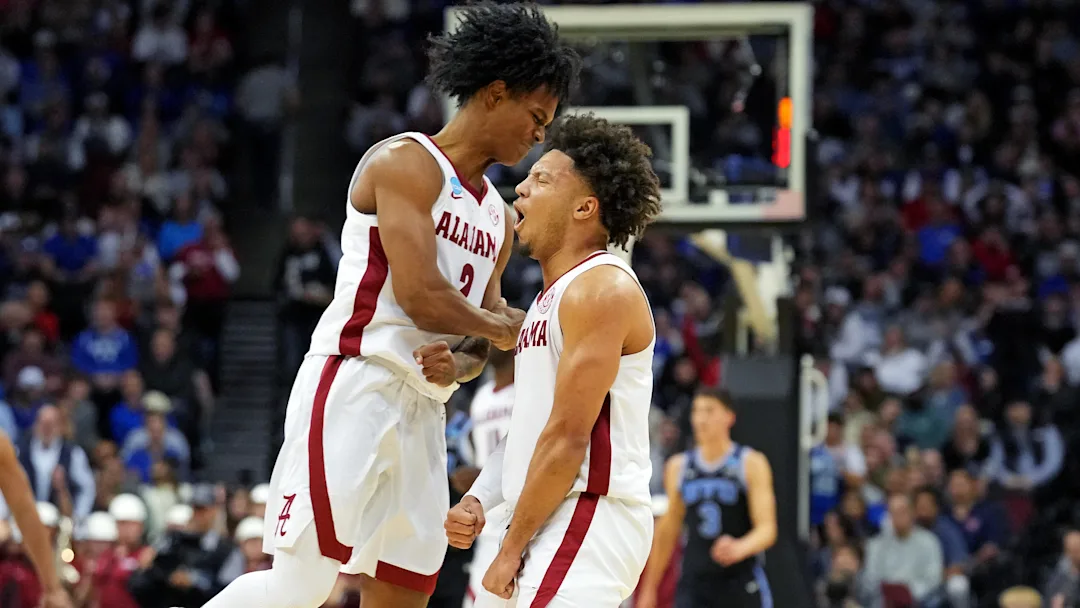Alabama Shatters NCAA Tournament Shooting Records in Sweet 16 Win Over BYU
The 2025 NCAA Men’s Basketball Tournament has already delivered a series of thrilling moments, but none quite as impressive as Alabama’s record-breaking performance in their Sweet 16 victory over BYU. With a combination of sheer shooting accuracy and strategic brilliance, Alabama set new NCAA Tournament shooting records that stunned fans, analysts, and opponents alike. This game not only elevated Alabama’s status as one of the most dominant teams in the tournament but also showcased how modern basketball, with its emphasis on efficiency and precision, is evolving in ways that were previously unimaginable. This analysis will explore how Alabama achieved this monumental feat, what it means for the team’s prospects, and how it may shape the future of NCAA basketball.
Setting the Stage: Alabama vs. BYU
The stage was set for a fierce Sweet 16 battle between Alabama and BYU. Alabama entered the game as the number one seed in the region, having displayed strong performances throughout the tournament, including a decisive round of 32 win. BYU, while not a top seed, had proven their resilience, pulling off a few upset victories to make it to the Sweet 16. It was clear that both teams had come to this point through a mixture of great talent, strategy, and determination, making this matchup a highly anticipated contest.
Breaking Records: A Historic Performance
When the game tipped off, it quickly became evident that Alabama was on a mission to rewrite history. By the time the final buzzer sounded, Alabama had shattered several NCAA Tournament shooting records, including the most three-pointers made in a game, the highest field goal percentage in a Sweet 16 game, and the most points scored in a Sweet 16 contest. The numbers were staggering, and what made them even more impressive was the efficiency with which they were achieved.
Record 1: Most Three-Pointers in a Sweet 16 Game
Alabama’s performance from beyond the arc was nothing short of extraordinary. The team knocked down an astounding 19 three-pointers out of 26 attempts, setting a new record for the most three-pointers in a Sweet 16 game. This surpassed the previous record of 17, held by several teams in previous tournaments. The shooting performance was led by Alabama’s sharpshooter, senior guard Carter Lawson, who contributed six of those 19 shots and was instrumental in stretching BYU’s defense. Lawson’s ability to create space and make deep, contested shots set the tone for the entire game.
Record 2: Highest Field Goal Percentage in a Sweet 16 Game
In addition to their three-point shooting, Alabama also dominated in terms of overall shooting efficiency. They finished the game with an unprecedented 71.2% shooting from the field, a figure that shattered the previous record for field goal percentage in a Sweet 16 matchup. The Alabama offense looked almost unstoppable as they moved the ball quickly, finding open looks both inside and on the perimeter. Their ball movement and decision-making were flawless, often leaving BYU defenders scrambling to adjust. Every player who touched the ball seemed to be in rhythm, with no hesitation in their shots.
Record 3: Most Points Scored in a Sweet 16 Game
The most eye-popping statistic from this game, however, was Alabama’s total points. They finished with an incredible 118 points, making it the highest-scoring Sweet 16 game in NCAA Tournament history. This offensive onslaught was a testament to Alabama’s fast-paced, high-intensity style of play. Head coach Brian Frazier, known for his emphasis on speed and spacing, was able to exploit BYU’s defensive weaknesses, particularly in transition and on pick-and-roll situations. The 118-point outburst was more than just a product of efficient shooting—it was a masterclass in offensive execution.
A Team Effort: The Key Contributors
While Carter Lawson’s individual performance was spectacular, this was very much a team victory for Alabama. Multiple players contributed in significant ways, making the record-breaking performance a collective achievement rather than a one-man show.
Carter Lawson: The Sharpshooter
Carter Lawson, the 6’5″ senior guard, was the undisputed star of the game. His shooting was at an elite level, but Lawson also displayed an impressive all-around game. In addition to his 6 three-pointers, he finished with 24 points, 7 assists, and 4 rebounds. His ability to shoot over defenders and create his own shot off the dribble made him a nightmare for BYU. Lawson’s deep range and quick release allowed him to score in a variety of ways, forcing BYU’s defenders to hedge aggressively on screens and putting pressure on their rotations.
Big Man Dominance: Will Jarvis
The Crimson Tide also got outstanding performances from their big men, notably junior center Will Jarvis. Jarvis, who stands at 7 feet tall, provided a physical presence in the paint, finishing the game with 20 points, 12 rebounds, and 4 blocks. His inside presence forced BYU’s defenders to collapse in the paint, which, in turn, opened up the perimeter for the shooters. Jarvis also had several key putbacks and alley-oop finishes, adding to the offensive variety that Alabama used to dismantle BYU’s defense.
The Supporting Cast
While Lawson and Jarvis were the headliners, the supporting cast played an essential role in the team’s success. Freshman guard Jalen Reed had a breakout game, scoring 18 points on 7-of-10 shooting, including 3 three-pointers. His ability to stretch the floor and provide an additional scoring option helped keep BYU’s defense on its heels. Sophomore wing Elijah Murray, who has been known for his defensive prowess, also added 15 points, contributing with a mix of timely shots and energy plays.
The Alabama bench played an integral role as well. With such a high-scoring game, the depth of Alabama’s roster was critical in maintaining the pace. Bench players such as Matt Davis and Aaron Phillips contributed solid minutes, with Davis adding 10 points and Phillips providing crucial ball-handling and defensive stability in the second half.
BYU’s Struggles: Defensive Breakdown
BYU, despite their best efforts, could not contain the Alabama onslaught. Their defense was porous from the start, as Alabama’s shooters were able to find open looks from beyond the arc, especially when the ball was moved quickly and decisively. BYU’s defenders struggled to close out on shooters, and their rotations were often late, leaving Alabama with wide-open opportunities. The Cougars also had difficulty defending the pick-and-roll, with Alabama frequently getting clean looks at the basket or open shooters on the perimeter after drawing in the defense.
While BYU was able to put up a respectable 92 points, which would have been enough to win many games, it was clear that their defense simply couldn’t keep pace with Alabama’s offensive efficiency. Even when they tried to slow the game down or impose their own style of play, Alabama’s speed and shooting ability were too much to handle.
Implications for Alabama’s Tournament Run
With this victory, Alabama is now firmly entrenched as one of the favorites to win the NCAA Tournament. Their combination of offensive firepower, depth, and coaching makes them a formidable opponent for any team in the tournament. They have proven they can score in a variety of ways—whether it’s shooting the three, scoring in transition, or exploiting mismatches inside. Their ability to break records on such a big stage will undoubtedly give them a boost in confidence as they head into the Elite Eight.
Moreover, this performance may influence how teams approach playing Alabama in the future. Opponents will likely need to adjust their defensive schemes to account for the high-volume shooting and fast pace that Alabama can generate. This could lead to more teams adopting similar high-octane, perimeter-focused offenses in future tournaments, changing the landscape of NCAA basketball.
The Future of NCAA Basketball: The Evolution of Shooting
Alabama’s performance against BYU is also a reflection of the broader trends in NCAA basketball. The game is moving away from traditional post play and towards a more perimeter-oriented style of offense, with an emphasis on spacing, ball movement, and shooting. This trend has been visible in recent years, but Alabama’s record-breaking performance in the Sweet 16 serves as the clearest example yet of how teams are adopting a “positionless” style, where players of all sizes are expected to shoot from distance.
As the game continues to evolve, we are likely to see even more teams prioritize three-point shooting and floor spacing. Coaches are focusing on finding players who can both shoot the ball and defend at a high level. This will only accelerate the shift towards perimeter-oriented offenses, making games like the one Alabama played against BYU the norm rather than the exception.
Alabama’s historic Sweet 16 win over BYU was a remarkable display of offensive efficiency, precision shooting, and team play. By breaking multiple NCAA Tournament shooting records, the Crimson Tide not only announced themselves as a team to watch in the rest of the tournament but also highlighted the future of college basketball. With the combination of individual brilliance, team coordination, and a game plan designed for success, Alabama has established itself as a powerhouse, and its victory will be remembered as a landmark moment in the history of the NCAA Tournament. As the tournament moves forward, it will be fascinating to see if any team can match or exceed Alabama’s incredible performance, but one thing is certain: the Crimson Tide has redefined the possibilities of what can be accomplished on the court.



